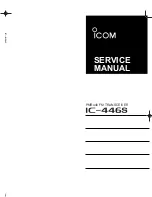
Page 19
Note: This setting should be set to “No” when there are multiple receivers in a
system. This will prevent the first receiver acknowledging receipt of the signal
and potentially stopping the SensorMATe transmission before other receivers
have received the data.
•
LoBatt.Al.Type
– This allows configuration of the type of alarm transmitted upon
automatic low battery transmission. It is selectable between “std/any” or “battery”.
•
Use ID1 for all? –
This setting allows all the connected sensors, the integral
temperature sensor and any fault conditions to send out the same alarm radio
code. Differentiation of the type of alarm raised from the connected sensors is
made by assigning different alarm types to the respective input devices.
•
Alarm ID no. 1
– Allows the assigned 4 digit hexadecimal radio code to be edited
to avoid conflicts between local devices. Note: Radio codes “0000” and “FFFF”
cannot be entered as alarm IDs.
•
Alarm ID no.2 to 8
– As above for IDs no 2 - 8 inclusive.
Note: Please see the table below for the default radio alarm ID allocation.
Display
Meaning
Alarm ID1 (LH ip)
Alarm ID for RJ12 Connector (left socket)
Alarm ID2 (LH ups.)
Upscale Alarm ID for RJ12 Connector (left socket)
Alarm ID3 (RH ip)
Alarm ID for RJ10/22 connector (Right Socket)
Alarm ID4 (RH ups.) Upscale Alarm ID for RJ10/22 connector (Right Socket)
Alarm ID5 (o.ofbed)
Alarm ID applicable to “Bed Usage” time
Alarm ID6 (PT err.)
Alarm ID sent upon detection of a Paper thin error
Alarm ID7 (temp.)
Alarm ID sent for a low or high temperature condition
Alarm ID8 (lo batt.)
Alarm ID sent for a low battery condition
7.7 Test Mode
This menu shows the condition of both of the inputs and can be used to confirm sensor
operation or operating conditions for equipment configuration.
The screen displays a “-“symbol against the relevant input pins when the connection is
open circuit and a “C” when the connection is closed.
Radio transmissions can also be tested in this area. To test a transmission, use the up
and down arrows to select the relevant transmitter ID#. This is shown in reverse video in
the center of the display. Upon selection of the “Enter” button the SensorMATe will
transmit the relevant radio code; the selected ID# will change to an Antenna symbol
during transmission.
Summary of Contents for Possum 034-892
Page 1: ...Technical Manual SensorMATe 3 Version 1 ...
Page 2: ...Page 2 Copyright Possum 2017 SensorMATe 3 Technical Manual Version 1 5th January 2017 ...
Page 23: ...Page 23 10 Declaration of Conformity ...
Page 24: ...Page 24 ...
Page 29: ...Page 29 Notes ...
Page 30: ...Page 30 14 WEEE Information ...












































